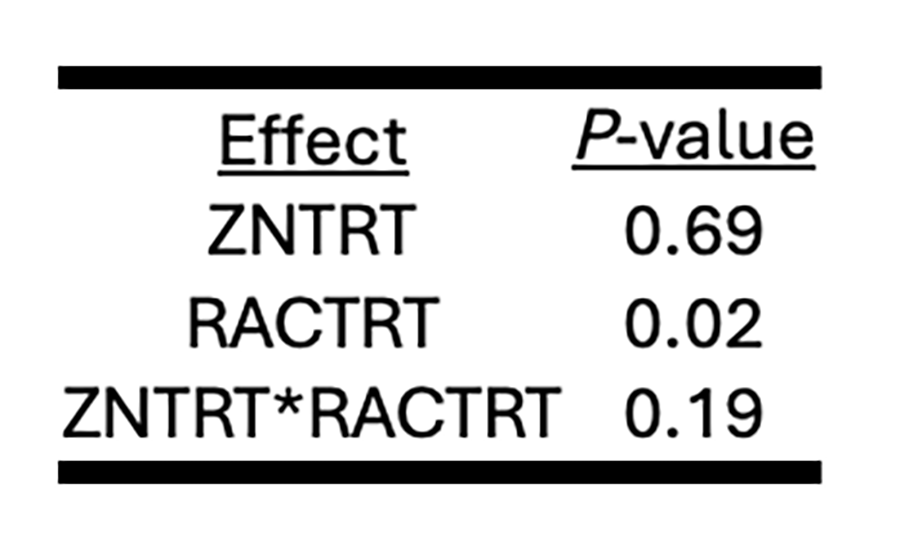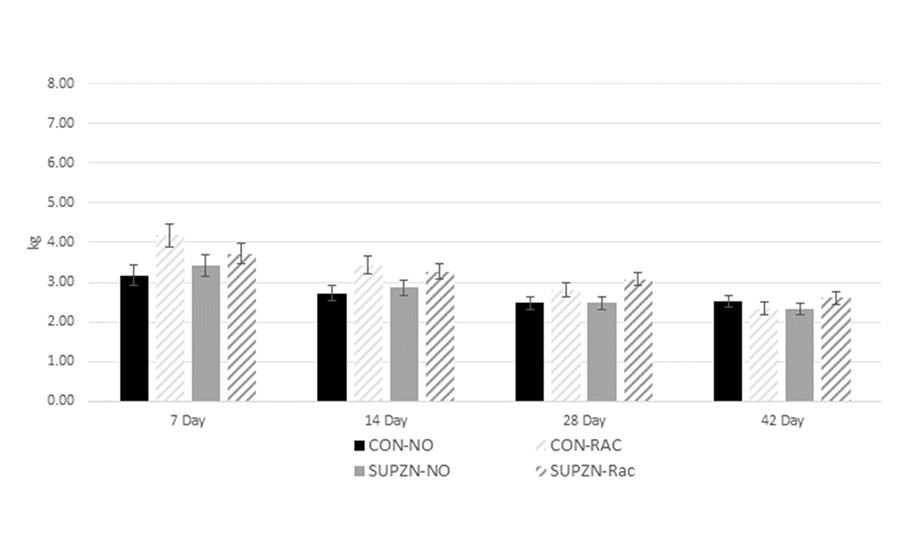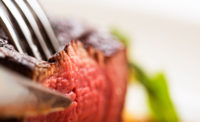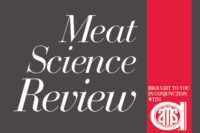Beef producers continue to address the challenge of improving production efficiency and sustainability while balancing the consumer demand for high-quality, tender, fresh beef. Feeding strategies to improve the efficiency of beef cattle production, such as supplementation of the beta-agonist ractopamine hydrochloride (RH) and the trace mineral zinc (Zn), can positively impact the sustainability of beef production. The impact of these practices on beef tenderness should be defined.
The impact of RH and Zn feeding on muscle and meat quality is not fully understood. Supplementation of RH has consistently shown a small but negative impact on tenderness1. Zn supplementation has shown mixed results on aged beef tenderness, with some studies showing no impact and others showing a small, positive impact of improving beef tenderness2,3. These variations in research study results can be due to the dosage, feeding duration, implant history, breed, and source of Zn.
In a previous study, we demonstrated that cattle supplemented with only Zn had a lower ribeye muscle pH at six hours postmortem and more tender steaks (lower shear force [an instrumental measurement estimating tenderness] values) at one-day postmortem compared to cattle not supplemented Zn2. Muscle from cattle that were supplemented with only RH for the final 28 days before harvest had a higher pH at six hours postmortem and less tender steaks (greater shear force values) at one-day postmortem compared to all other treatments, which was linked to less protein degradation (an indicator trait of tenderness). In that study, when Zn and RH were fed in combination, the positive influence of Zn on postmortem pH and tenderness values was nullified. The positive impact of Zn supplementation on tenderness development was shown at one-day postmortem but not any other day (3, 7 or 14) of aging. Beef from cattle fed Zn had a more rapid improvement in tenderness but no difference in the extent of tenderness compared to other treatments. The influence of these production practices on tenderness development with longer aging times was not addressed in these studies but should be investigated.
In the current study, it was hypothesized that Zn and RH supplementation would impact tenderness development of steaks aged for more than 14 days postmortem. The objective of the experiment was to characterize how Zn and RH supplementation affects postmortem tenderness development and protein degradation of ribeye steaks throughout aging.
Crossbred Angus steers (seven steers per treatment) were fed one of four diets: control (CON-NO; no supplemental Zn or RH; analyzed 36 mg Zn/kg dry matter), supplemental Zn only (SUPZN-NO; CON diet + 60 mg Zn/kg dry matter from ZnSO4 + 60 mg Zn/kg dry matter from Zn-amino acid complex for the 89-day trial), RH-only supplementation (CON-RAC; 300 mg RAC per steer per day starting 28 days before harvest) and supplementation of Zn and RH (SUPZN-RAC; SUPZN-NO and CON-RAC diets combined).
At finishing weights (greater than 1,590 pounds), steers were harvested at a commercial processing facility, and carcass characteristics were collected, at two days postmortem. Samples of the ribeye roll (longissimus thoracis) from each carcass were taken at two days postmortem for biochemical analysis, and ribeye rolls from the other side of the carcass were collected and aged for seven, 14, 28, and 42 days postmortem. Shear force values were measured at seven, 14, 28, and 42 days postmortem. The tenderness of fresh beef is highly influenced by enzymes in muscle that break down muscle proteins. One of the most important of these enzymes is known as calpain-1. Desmin is a protein in muscle that can be broken down by calpain-1. Degradation of desmin is known to be an indicator of tenderization. Calpain-1 autolysis (a measure impacted by the activity of calpain-1) at two days postmortem and desmin degradation (two, seven, 14, 28, and 42 days postmortem) were analyzed on ribeye muscle samples.
Ribeyes from cattle supplemented with RH were less tender (greater shear force values) at seven, 14, and 28 days postmortem than ribeyes from cattle not supplemented with RH. Ribeye muscle from cattle supplemented with RH had less protein degradation (less calpain-1 autolysis at two days postmortem and desmin degradation at two, seven, 14, and 28 days postmortem) than cattle not supplemented with RH. Supplementation of Zn resulted in more protein degradation with more calpain-1 autolysis than ribeye muscle from cattle supplemented with RH and more desmin degradation than all other treatments at two days postmortem, but significant differences in tenderness values were not observed at any point in time — only numerically lower values compared to treatments fed RH (seven, 14 and 28 days postmortem).

Consistent with our previous studies, Zn treatment resulted in a more rapid improvement of tenderness, but not a greater extent of tenderness development during longer aging times. The results confirm that supplementation of RH continues to result in a small, but negative, impact on tenderness development. The negative effect of RH treatment on tenderness was observed at seven, 14, and 28 days postmortem but not in steaks aged 42 days. The explanation for tougher steaks at seven, 14, and 28 days was due to less protein degradation characterized in this study by measuring desmin degradation. Zn supplementation showed evidence of enhanced proteolysis early postmortem (two days), demonstrating the potential influence of Zn on tenderness development early postmortem and numerically lower shear force values than ribeye steaks from cattle supplemented with RH. The study confirms that nutritional supplementation strategies can impact the rate of tenderness development impacting the rate of protein degradation during the aging process.

Figure 1. Effect of supranutritional zinc (Zn) and ractopamine hydrochloride (RAC) supplementation on Warner-Bratzler shear force values of beef ribeye steaks at different postmortem time points.1,2,3
1CON = no supplemental Zn, analyzed 36 mg Zn/kg dry matter; SUPZN = CON + 60 mg Zn/kg dry matter from ZnSO4 + 60 mg Zn/kg dry matter from Zn-amino acid complex (Availa-Zn; Zinpro Corporation, Eden Prairie, MN). Fed for the entire 89 d trial.
2NO = no supplemental RAC; RAC = 300 mg RAC per steer per d (Actogain45; Zoetis, Parsippany, NJ) starting 28 d before harvest.
3Warner-Bratzler shear force values were averaged across two adjacent steaks.
References
1Lean, I. J., J. M. Thompson, and F. R. Dunshea. 2014. Meta analysis of zilpaterol and ractopamine effects of feedlot performance, carcass traits and shear strength of meat in cattle. PLoS ONE 9:e115904. https://doi.org/10.1371/journal.pone.0115904.
2Schulte, M. D., K. G. Hochmuth, E. M. Steadham, K. J. Prusa, S. M. Lonergan, S. L. Hansen, and E. Huff-Lonergan. 2021. The influence of supranutritional zinc and ractopamine hydrochloride supplementation on early postmortem pH decline and meat quality development of beef. Meat Muscle Biol. 5:1–15. https://doi.org/10.22175/mmb.12250.
3Vellini, B. L., L. F. Prados, F. P. Monção, A. K. Fireman, F. D. Resende, and G. R. Siqueira. 2020. Zinc amino acid complex in association with chromium methionine improves the feed efficiency of finished Nellore cattle in the feedlot. Anim. Feed Sci. Tech. 262:1–12. https://doi.org/10.1016/j.anifeedsci.2020.114430.




Report Abusive Comment